Sam Browne Equipment: Components: Equipment Carriers
Case, Pistol
Case, brown, pistol, “Sam Browne.” (Mark I.)
Case, brown, pistol, “Sam Browne.” (Mark II.)
Case, pistol, Sam Browne, Mark II.
Case, pistol, “Sam Browne”
Stores Ref. A1/AA 0650 Case, pistol, Sam Browne
Stores Ref. CN/AA 0650 Case, pistol, Sam Browne
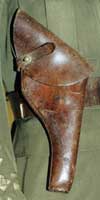
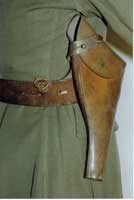
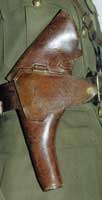 The reverse of the Holster has the design features that make an old form of Holster very specifically “Sam Browne”. It was designed specifically for wear on the right side only, with a fairlead for the Belt, stitched tightly to allow no rotational movement. A piece of leather, of inverted trapezoidal shape, was stitched on with an alignment that canted the butt forward and the barrel backwards. Sam’s intention was to avoid hitting your horse, should the pistol discharge accidentally! The rear vertical edge of the fairlead was extended to carry a Billet hook, which then fitted into a punched hole in the belt, to prevent lateral movement (see detail at right). Unlike Sam’s original, the flap was secured by a billet and stud. A brass loop, on a chape, were sandwiched between the upper edge of the fairlead and the Holster body. This allowed a fixing point when double Braces were used, without recourse to a dee on a runner. LoC 11267 introduced the Mark II, noting only that it had been made of lighter materials. In November 1918, LoC 21689, as with the Waist belt, etc., introduced minor changes to the syntax, giving Case, pistol, Sam Browne, Mark II. In 1924, LoC A 3, removed the Mark II designation from the nomenclature. The quotation marks having been removed by LoC 21689 in 1918, they now suddenly reappeared, both in the Old and New Designations, though not in the Vocabularies! The example at left has unaccountably had the short edge of the pointed LH end stitched. This means the Belt cannot lie against the main fairlead stitching. For LoC C 4686, reference should be made to the Waist belt page. From the John Bodsworth Collection, photograph © John Bodsworth 2010.
The reverse of the Holster has the design features that make an old form of Holster very specifically “Sam Browne”. It was designed specifically for wear on the right side only, with a fairlead for the Belt, stitched tightly to allow no rotational movement. A piece of leather, of inverted trapezoidal shape, was stitched on with an alignment that canted the butt forward and the barrel backwards. Sam’s intention was to avoid hitting your horse, should the pistol discharge accidentally! The rear vertical edge of the fairlead was extended to carry a Billet hook, which then fitted into a punched hole in the belt, to prevent lateral movement (see detail at right). Unlike Sam’s original, the flap was secured by a billet and stud. A brass loop, on a chape, were sandwiched between the upper edge of the fairlead and the Holster body. This allowed a fixing point when double Braces were used, without recourse to a dee on a runner. LoC 11267 introduced the Mark II, noting only that it had been made of lighter materials. In November 1918, LoC 21689, as with the Waist belt, etc., introduced minor changes to the syntax, giving Case, pistol, Sam Browne, Mark II. In 1924, LoC A 3, removed the Mark II designation from the nomenclature. The quotation marks having been removed by LoC 21689 in 1918, they now suddenly reappeared, both in the Old and New Designations, though not in the Vocabularies! The example at left has unaccountably had the short edge of the pointed LH end stitched. This means the Belt cannot lie against the main fairlead stitching. For LoC C 4686, reference should be made to the Waist belt page. From the John Bodsworth Collection, photograph © John Bodsworth 2010.
 A hook was rivetted to the extension of the belt loop of the Pistol case. Its form betrays its origins in a component of a horse's bridle. In civilian terms, the item at left is a Bridle Cheek Piece, the military nomenclature of which is Bridle Head, Short Piece. Note the Billet Hook, here a nickel-plated item which, in brass, served to fix the Pistol case in position on the belt, with a user-punched hole to suit. From the Rog Dennis Collection. Photographs © Rog Dennis 2010.
A hook was rivetted to the extension of the belt loop of the Pistol case. Its form betrays its origins in a component of a horse's bridle. In civilian terms, the item at left is a Bridle Cheek Piece, the military nomenclature of which is Bridle Head, Short Piece. Note the Billet Hook, here a nickel-plated item which, in brass, served to fix the Pistol case in position on the belt, with a user-punched hole to suit. From the Rog Dennis Collection. Photographs © Rog Dennis 2010.
 Detail of the Billet hook shown above.
Detail of the Billet hook shown above.
Case, pistol, Sam Browne – Variants
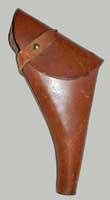
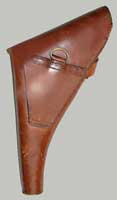 It is impossible to be “comprehensive” about these, as there are just too many. The strap securing the flap varies in position, angle, length and number of punched holes. Even the flaps can differ, some having a greater coverage of the pistol butt. Most have the “standard” belt fairlead, but some lack the extension for the billet hook, whilst others have a fairlead which is too wide, allowing the Case to rotate. Most have a brass loop for attachment of the shoulder strap, but some do not.
It is impossible to be “comprehensive” about these, as there are just too many. The strap securing the flap varies in position, angle, length and number of punched holes. Even the flaps can differ, some having a greater coverage of the pistol butt. Most have the “standard” belt fairlead, but some lack the extension for the billet hook, whilst others have a fairlead which is too wide, allowing the Case to rotate. Most have a brass loop for attachment of the shoulder strap, but some do not.
Designed for wear on the right-hand side, for a right-handed draw, there are variants for wear on the left, for a cross-draw. There are also left-hand Holsters for a left-handed draw, which can be moved to the right for a left-handed cross-draw. As the fairlead was supposed to be a tight fit, a right-hand Holster cannot simply be slid round to the left of the belt. The various brace loops and sword rings interfere with this transfer, so left-handed Holsters are characterized by having a longer loop that fastened with either a buckle, or to a stud. There was even a “leg holster”, but thankfully this was observed on an officer in the newly formed Irish Free State Army. It can therefore be omitted!
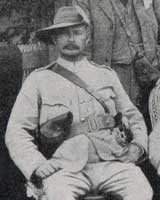 The photograph at left was taken from the Boer War era publication Black & White Budget, Vol. 1 No. 13. It shows officers of the Diamond Field Horse, all wearing their Holsters on the right. The photo is not reversed. That many LH'd officers?! I don't think so! My bet is they're all RH'd and draw the pistol with back of hand touching the right side. It's a bit like drawing bayonets (1st Drill move) - but with left hand.
The photograph at left was taken from the Boer War era publication Black & White Budget, Vol. 1 No. 13. It shows officers of the Diamond Field Horse, all wearing their Holsters on the right. The photo is not reversed. That many LH'd officers?! I don't think so! My bet is they're all RH'd and draw the pistol with back of hand touching the right side. It's a bit like drawing bayonets (1st Drill move) - but with left hand.
Officers’ revolvers had to use .455-in. Service ammunition, However, many officers evidently purchased their own ammunition, for Colt M1911 .45 Automatics, so Army Ordance Department depots could also supply Colt Automatic calibers of .45, .38 and .32 inches. In the Boer War “Broomhandle” Mauser automatics are evident. Holster design had therefore to be modified for these different shapes and barrel lengths. When swords were ordered to be abandoned in the field, many Holsters were both manufactured, or modified, to have short straps usually fitted with dog-clips. These connected to the sword rings. The change to a .38 revolver also led to smaller Cases, often on short straps with dog-clips, such as that seen in 2WW photographs of H.M. King George VI.
LoC C 6788 finally made the Pistol case obsolete in 1955, the year in which the Sam Browne Belt finally became a ceremonial item.
© R.J. Dennis July 2010